So, you’ve decided to drive your home on wheels instead of towing it. Now comes the question: what’s the differences between a Class A motorhome and a Class C motorhome?
In general, Class A RVs are larger than Class C RVs; they have a flat front and offer more living and storage space. While Class C motorhomes are typically smaller, they also come with benefits such as drivability and better gas mileage.
But, there are many different factors to consider in addition to size and fuel economy. So, deciding between a Class A RV and a Class C RV can be difficult, as both have their own list of pros and cons.
For this reason, we’ve created the ultimate Class A vs Class C guide to help decide find out whether a Class A or Class C RV is best for you and the way you like to camp and travel.
So grab a drink, keep scrolling, and let’s talk motorhomes.
What Is a Class C Motorhome?
Class C RVs range from stubby little 19 ft. rigs to 40’ long motorhomes. More often than not, however, most Class C motorhomes fall within the 30’ range.
As mentioned before, they are usually smaller than Class As, with a sleeping/storage area over the cab.
They are typically built on a heavy-duty truck frame, such as a Ford E350/E450, and have a van-like front.
This can make driving a Class C much less intimidating than a Class A, since most people feel comfortable driving a van or a truck, but not necessarily a bus (and by “most people” I mean me).
In addition, most Class Cs are powered by gasoline, except for some “Super-Cs” which are powered by diesel.
And while their features can seem limited compared to large motorcoaches, their maneuverability makes up for it.
Now, let’s dive into the pros and cons of Class C motorhomes.
Pros of Class C RVs
1. Class C RVs Are easier to drive.
Some might disagree with this point, as it really comes down to personal preference.
However, if you’re not used to driving big rigs, it can be far less intimidating to jump in the cab of Class C and hit the open road.
The driver’s area is similar to that of a van or truck, making it an easier transition from driving everyday vehicles.
Couple that with the fact they are typically much lighter and smaller, and you’ll find that driving through cities and mountain ranges are less of an issue than in a Class A.
2. They’re more family-friendly.
Class Cs tend to be laid out in a way that accommodates more people.
They typically have more passenger seating than a Class A (i.e., more seatbelts) and despite their smaller size, there are usually more beds.
If you combine the loft sleeping area, the sleeper couch, the dinette that transforms into a bed, and a queen-sized bed in the back (smaller versions may not have this), you could easily sleep between 7-8 people. I’ve even seen Class Cs that sleep 11!
3. Most Class C Motorhomes fit into smaller campsites.
This really depends on how big your Class C is, as some reach almost 40 feet long.
More often than not, however, Class Cs are smaller than Class As. Not only are they typically shorter, they don’t have the clearance restrictions that a Class A will have.
Specifically, the average Class C will measure about 30’ long and 11’ high, while the average Class A is around 35’ long and 12.5’ high.
Thus, your Class C will most likely be smaller and you’ll have more campsites to choose from! This is especially important when traveling through National Parks, as many of the NP campgrounds have size restrictions.
4. They’re easier to resell.
Now, I have to admit, I haven’t had personal experience reselling a Class C motorhome.
But I have had experience reselling a Class A, and let me tell you, it was tough.
We had a remodeled 2000 Winnebago Adventurer that was in great shape and reasonably priced, but I can’t tell you how many prospective buyers decided it was just too much for them.
People who are only planning to use their RV on weekends and the occasional trip are often intimidated by such a big rig (understandably).
There is no doubt, Class Cs seem a little less daunting. Additionally, they are usually priced cheaper, which makes their time on the market that much shorter.
5. You’ll get better MPGs.
Class C RVs typically have better fuel economy (albeit, not by much).
Depending on the size and type of your Class C, the terrain you’re driving on, and whether or not you’re towing, you can expect to get between 7 and 15 MPGs.
On the other hand, Class A fuel economy falls within the 5-10 MPG range.
To put it into perspective, we had a gas-powered Class A with a Ford V10 engine, and we got around 6 MPGs while towing our small car (sometimes even less). Yeah, not great.
Therefore, if fuel economy is a top priority of yours, you may want to consider a Class C.
6. They’re easier to repair and maintain.
Because Class C motorhomes have a van-like front and a shorter height clearance, you’ll probably find them easier to repair and maintain.
And, if you’re a DIYer, working on your own rig is much easier with a hood that pops just like a car.
On the other hand, Class As come with a flat front, and in gas-powered rigs, the engine access is in the front of the RV and under the doghouse cover inside.
This makes working on your own rig a bit awkward compared to Class Cs (as my husband sadly found out).
In addition to doing your own repairs, it will be much easier to find a repair shop that accommodates your Class C.
Most Class Cs can fit into standard garage bays, while you may have to find a special shop that works on Class As.
7. Class C RVs Are typically cheaper to buy.
New Class C motorhomes usually cost between $50,000-$100,000, with “Super-Cs” costing well into the hundreds of thousands.
You may even find a decent used Class C as low as $15,000, depending on a variety of factors such as wear and tear, mileage, and features.
Compare this to new Class As, which easily cost over $100,000 (with a decent used one anywhere between $20k and $75k), and it’ll feel much easier to pull the trigger on a Class C.
Cons of Class C RVs
1. The cab space isn’t livable.
I can imagine deciding to upgrade from a Class C to a Class A and breathing a sigh of relief when I see the cab.
In Class Cs, the driving area is separate from the rest of the interior (you have to step down “into” it).
This can make the cab feel like wasted space in a home that is already tiny.
Class As, on the other hand, have a very spacious living area which includes the cab.
In most models, the driver and the passenger seat both turn around to face the interior, adding more seats to your living space!
2. They have limited towing capacity.
Towing capacity depends on several factors such as horsepower, torque, and weight.
But generally speaking, Class Cs typically tow between 3,500 and 8,000 lbs, depending on the rig.
To put it plainly, you probably won’t be able to tow an SUV or truck with a smaller Class C RV.
However, gas-powered Class As typically tow around 5,000 lbs (diesel-pushers can tow between 10,000-15,000 lbs!), giving you more options for towing with a Class A.
The exception to this is “Super Cs” which can tow up to 40,000 lbs! But for the purpose of this article, we’ll focus on the most common Class Cs.
3. They have a smaller living area.
There is no doubt, the living area of a Class C just doesn’t compare to that of a Class A.
Even larger Class Cs tend to have lower ceilings, smaller windows, and fewer slides than Class As do.
Class A owners are constantly raving about their rig’s floor space, especially when the slides are out.
And while you will have everything you need in your Class C (including more places to sleep), you may feel more claustrophobic in a Class C RV compared to a Class A RV.
4. They have less storage space.
Unfortunately, Class C owners will probably find themselves with less storage space than Class A owners.
This goes for both interior and exterior storage. Class As usually have larger pantries and closets, while also making great use of the “basement” area where the water tanks sit.
Some Class As even have exterior storage that spans the entire width of the rig!
5. They’re not as durable.
This one comes down to what the RV is made of. Many times, Class C frames and studs are made with wood.
This makes the living area vulnerable to rot, should any water damage occur.
This may also be an issue if you find yourself camping in colder climates, as the moisture from heating and cooking can build in your ceiling and walls, causing water damage from the inside (and if there’s anything you shouldn’t mess around with, it’s mold).
This factor may also dramatically affect the resale value, as almost anyone in the market for a used RV is going to ask about water damage.
Now that we’ve covered all there is to know about Class Cs, let’s talk Class As.
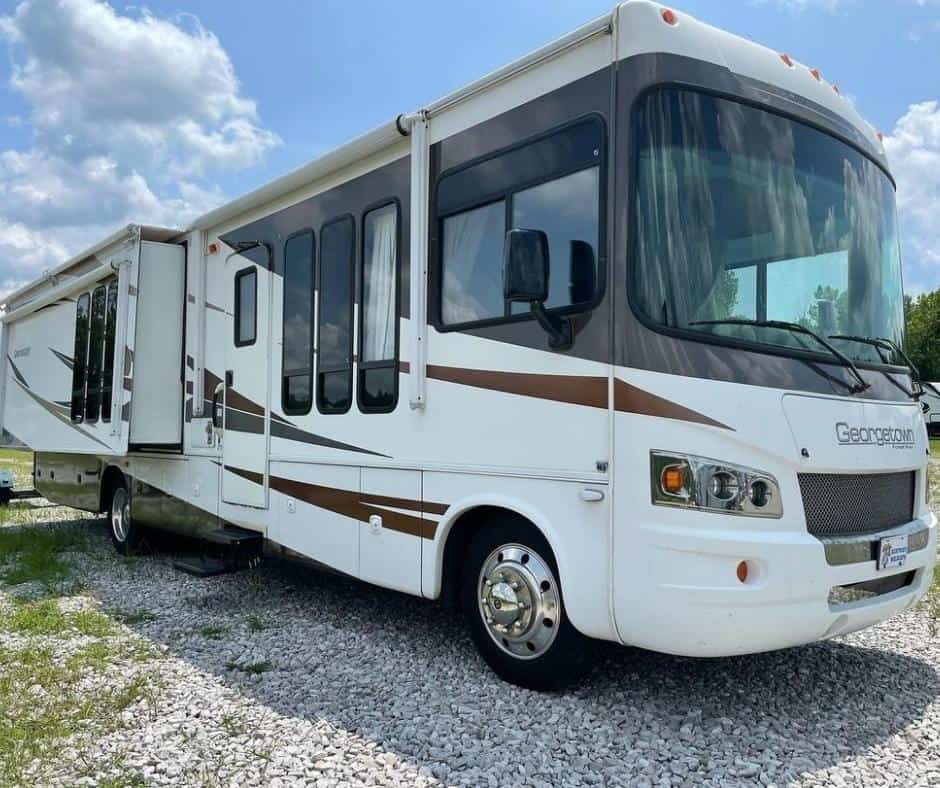
What is a Class A Motorhome?
Ok, I’ll say it: Class A RVs are straight-up buses. They are among the tallest of the RVs (over 12’) with lengths spanning between 32 and 45 feet.
Class A motorhomes are built on a chassis similar to that of an 18-wheeler and therefore are much heavier than other rigs.
Without a doubt, the size of these RVs allows for some luxurious living. Most newer Class As have at least one slide-out, with some containing multiple massive slides.
Moreover, some Class A motorhomes run on gas, while others are powered by diesel. In diesel-powered rigs, the engine is located in the back (hence the name “diesel-pusher”) while in gas-powered rigs, the engine is located in the front.
You can immediately tell if a Class A takes gas or diesel: simply look at where the entrance door is located.
If the door is located in the middle of the RV, it’s probably a gas-powered motorhome; if the entrance door is located near the cab, it’s most likely a diesel-pusher.
There are a variety of other ways to tell the fuel source, but this one always stood out to me.
With all that a Class A offers, you would think buying one would be a no-brainer. However, there are definitely reasons to think twice before buying one.
Below, we discuss the pros and cons of Class As compared to Class Cs. Make sure to keep in mind your individual travel priorities as you read through!
Pros of Class A RVs
1. They have more water storage.
Calling all boondocking fanatics! Fresh, grey, and black water storage are important factors to consider, especially if you’re venturing off the beaten path.
If it wasn’t for my husband, I would have easily overlooked this aspect of our rig. Because the tanks are “out of sight, out of mind”, it can be easy to forget about storage limits.
Nevertheless, the amount of water an RV holds can differ dramatically between rigs.
Class As usually hold between 75-100 gallons of freshwater, with the grey and black tanks each holding approximately 50% of the freshwater capacity.
For example, our Winnebago Adventurer held 80 gallons of freshwater and about 40 gallons in both the grey and black tanks.
This was AMAZING for boondocking, since the more water you can hold, the less you have to rely on hookups.
Compared to a Class A, Class Cs simply don’t hold up; they only average around 35-60 gallons of freshwater storage.
2. The water tanks are located in the heated “basement”.
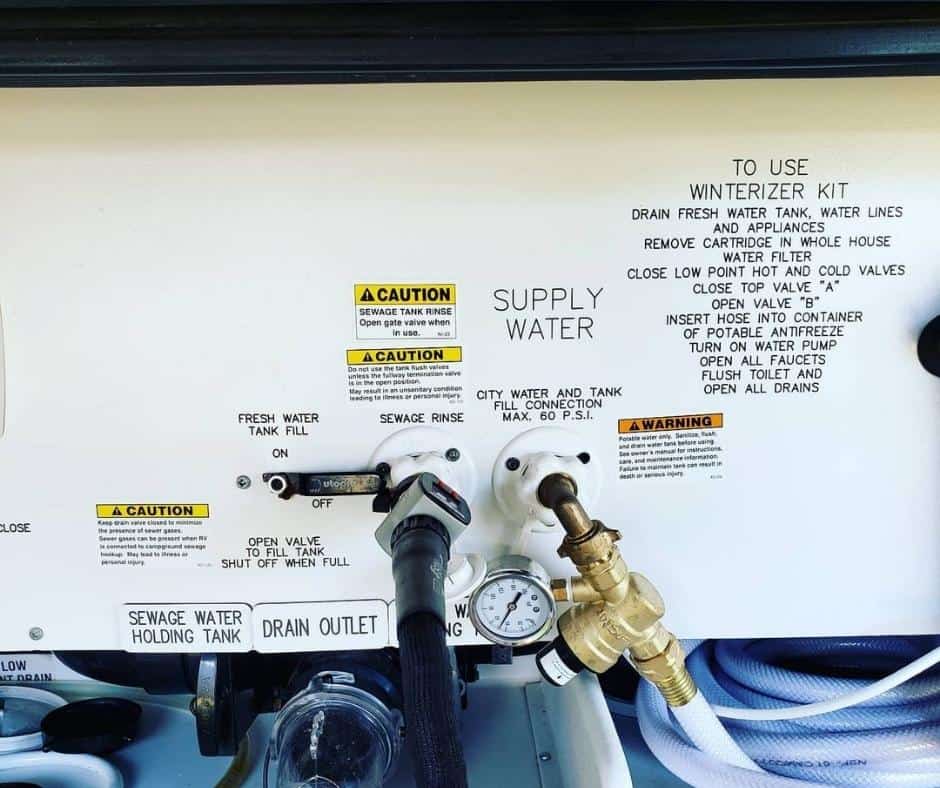
This is an amazing aspect of Class As, and I definitely took it for granted as an RVing newbie.
The water tanks are located underneath the motorhome, enclosed amongst the heating ducts (hallelujah!).
This means that your tanks and pipes won’t freeze as easily compared to rigs with exposed tanks.
Nevertheless, beware of very cold temperatures. Our water pipes held up amazingly – until we hit 12 degrees F one morning in New Mexico.
But even then, we had minor freezing with no damage done. Without a doubt, Class As are king when it comes to water storage and location.
3. They hold more fuel.
Hands down, Class As take the cake when it comes to fuel storage. The average Class A holds about 100 gallons of fuel, while the average Class C only holds about 25 gallons.
Talk about a difference! This means that a Class A can go over 800 miles without a fuel up, while a Class C can only make it around 400 miles (fuel economy taken into account).
You’ll therefore want to consider the distance you plan on driving and how often you’ll need to stop when making your decision.
4. They have better visibility while driving.
Not only do Class As have a massive windshield, they also tower above most vehicles on the road.
You feel like a king (or queen!) driving down the highway with the ability to see for miles in all different directions.
Not only is it a great feeling, but it helps with safety as well. You’ll be the first to spot a hazard up ahead and avoid any dangerous situations.
5. That panoramic view.
This might seem redundant, but really feel that the massive windshield deserves a second point.
You can’t truly appreciate it until you’re out there. Imagine having an amazing view of the sun setting over the gulf coast in the comfort of your own home; or witnessing the Guadeloupe Mountains come into view after driving on flat roads for hours.
The panoramic view that a Class A RV offers makes each moment on the road that much more memorable, and for some people, it is worth every disadvantage!
6. That spacious living area.
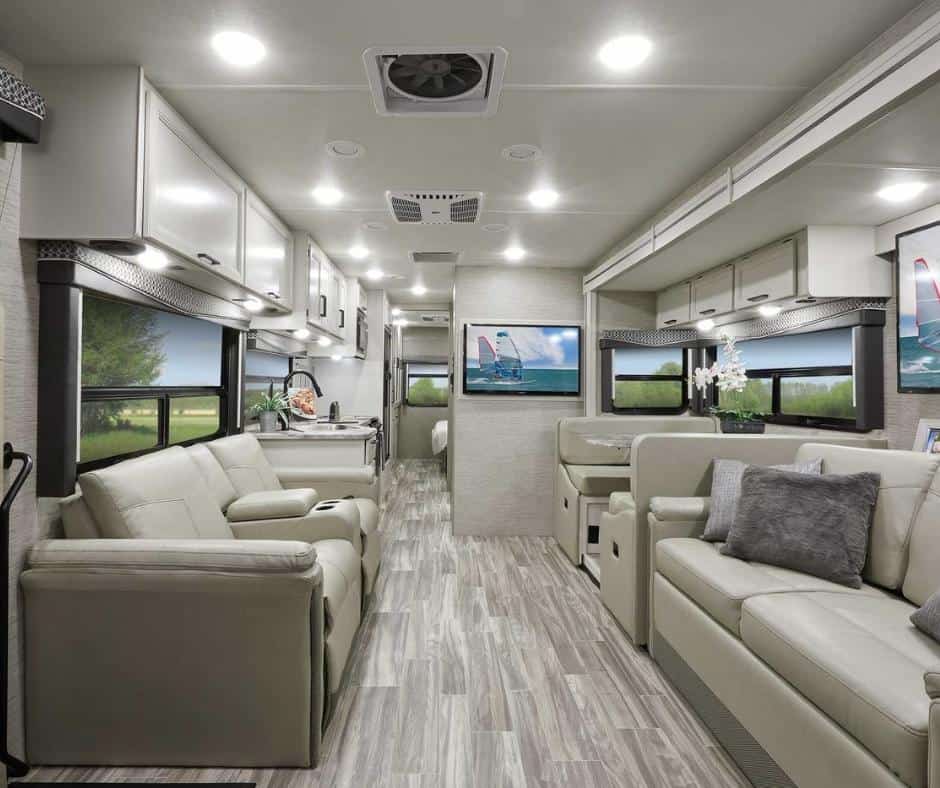
As mentioned previously, the living space in a Class A just doesn’t compare to that of a Class C.
Not only is the square footage larger, but the taller ceilings make it feel a lot bigger too (making it a better option if you’re not vertically challenged like I am).
Although not always, Class As typically have more slides as well, opening the interior up that much more.
7. They will last.
When we bought our Class A, I was a total RVing newbie. Aside from the little research I did, I had no idea what to look for when it came to purchasing a camper.
Thankfully, we got lucky when it came to the construction of our Class A. To our pleasant surprise, it was made entirely of metal, fiberglass, and laminated foam – making it virtually impossible to rot.
And thank the RV gods, because we definitely had some leaks around the slide.
This makes Class As much more durable than Class Cs, which are sometimes made with wood.
Because of this, always ask what materials your RV is constructed with, regardless of which RV you choose.
Cons of Class A RVs
1. They’re heavy.
Yes, those massive buses are heavy (shocker, right?). In fact, most Class A RVs weigh over 10,000 lbs.
Because of this, you’ll have to pay attention to weight restrictions on certain roads, as well as elevation (especially if you don’t have engine breaking).
My husband and I were in a gas-powered Class A and had no assistance from our engine to help slow down our RV.
In short, when we descended mountains, we had to make sure our brakes didn’t literally melt. Add this to low fuel economy, and you may want to think twice about a Class A.
2. They are expensive.
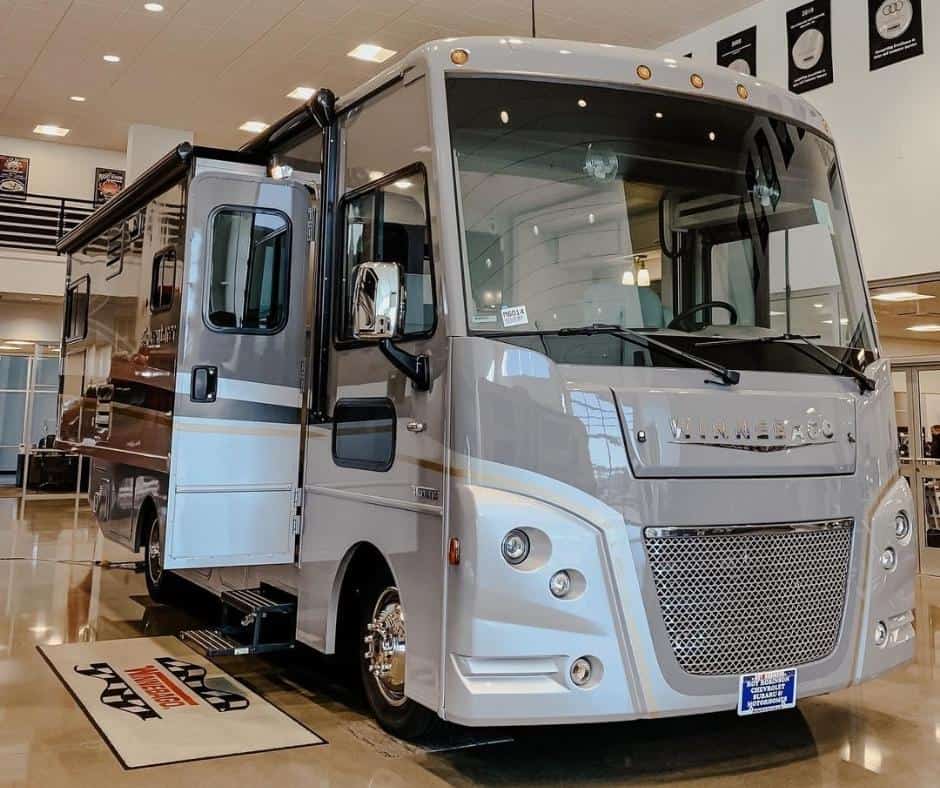
As touched upon previously, purchasing a Class A will typically cost you more than a Class C will.
However, in addition to upfront costs, maintenance costs will be high as well. Let’s look at the cost of tires, for example.
Tires for a midsize RV, such as a Class C, typically cost between $163 and $229 per tire, while tires for a Class A cost between $300 and $460 a tire.
This is because of the weight of the RV: the heavier an RV is, the better the tires need to be.
You can apply this to many other aspects of Class As, making them a more expensive option overall.
3. They’re intimidating to drive.
Well, excuse me if I wasn’t itching to suddenly jump into the driver’s seat of a gigantic bus and set off across the country (apologies to my husband, who drove almost the entire trip).
I can’t be the only one, right? For this reason, I’m including the Class A’s drivability under its list of cons.
As I mentioned before, going from a basic everyday vehicle to a Class A can be much more intimidating than jumping into a Class C.
Not only are you in a bigger vehicle, but the location of the driver’s seat is daunting in itself.
Sitting up high in a vehicle with a flat front can definitely feel nerve-wracking, and it’s something I personally never got used to.
4. They’re just so… Big.
A common sentiment you’ll hear from experienced RVers is that they wished they went smaller, not bigger.
After traveling 10,000 miles in a Class A, I can echo that sentiment. A beautiful thing about RVing is that it teaches you how little you need to be happy.
When we were out on the road, I remember realizing that we had been without hookups for three solid months, and incidentally, they were the happiest three months of my life.
Your RV is your tool to see the world. If you’re like me, you might find that the items you thought were essential are actually dispensable, and all they really did was slow you down. Bigger is not always better, especially when it comes to travel.
Class A vs Class C, which one should you choose?
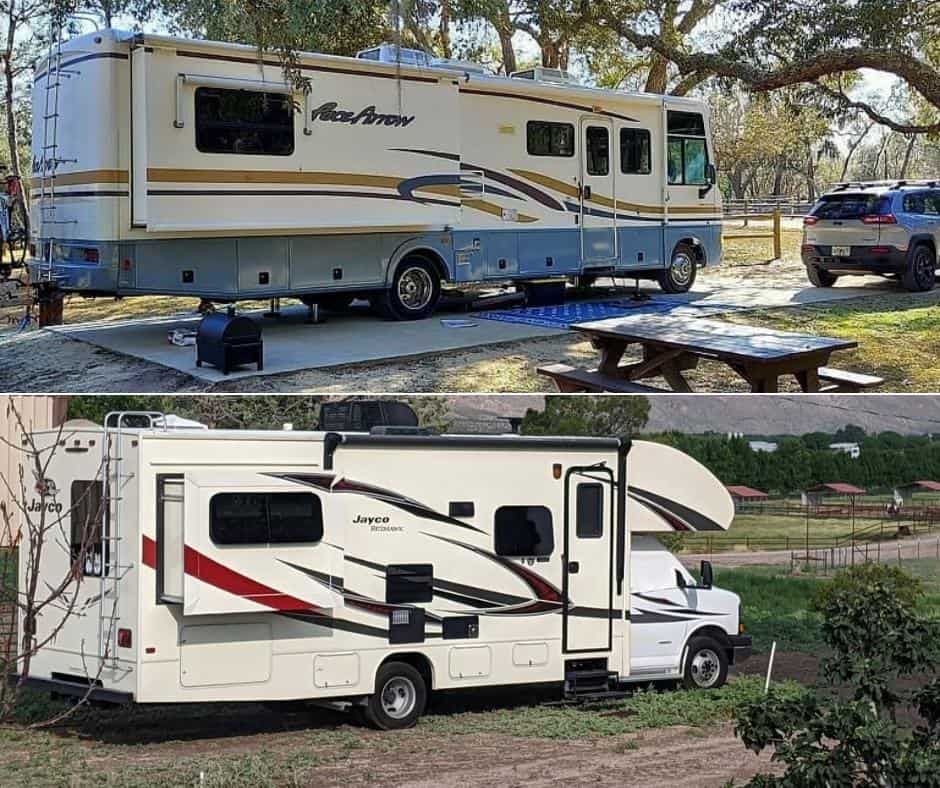
Now that your brain is overflowing with every advantage and disadvantage of these two motorhomes, it’s important to discuss how this information pertains to YOU.
After all, each family is different and each rig is different; a perfect setup for one person may be disastrous for another!
For this reason, it’s important to consider several factors when deciding which motorhome is best for you:
First, how you are going to use your rig?
Will you be living in it full-time? If so, Class A motorhomes are much more popular for full-timers.
The amount of storage and spaciousness they provide is great for anyone looking to move from sticks and bricks to a home on wheels.
And if you’re going to give up the responsibilities of a traditional home, the maintenance costs of a Class A might not feel as daunting.
On the other hand, does setting out on the open road with few limitations make your heart soar? Will you move from place to place rather quickly? If so, you may want to consider a Class C (especially a smaller one).
You’ll have everything you need, just in a smaller package. I have to admit, I found myself wishing we had a Class C at times during our cross-country trip.
The lightness and maneuverability sounded attractive after driving our Class A through big cities and mountain ranges.
Secondly, what is your budget?
Are you a retiree with a pension and money to spare? Are you comfortable spending the cash needed to keep your rig in tip-top shape? If so, a Class A might be perfect for you.
While all rigs have their maintenance expenses, Class As are the most costly, and in addition to repairs and maintenance, you’ll have to pay for that low fuel economy as well.
Nevertheless, if you can afford it, the perks that a Class A offers are unrivaled.
However, if you have a tighter budget (or simply want to spend less), you may want to consider a Class C.
Not only are they cheaper to buy and maintain, but you’ll have more options for storing your RV as well.
Class Cs are generally smaller and less assuming compared to Class As. Meaning, you might have better luck finding a free or inexpensive place to park it and avoid a costly storage fee.
Thirdly, how much space do you need?
Are you a single person, a couple, or part of a large family? If you’re the former, you might enjoy the freedom that a Class C gives you, while also being comfortable in a smaller space.
If you’re the latter, you might opt for a larger living space that doesn’t feel as claustrophobic with kids and pets running around.
To be honest, my husband and I essentially bought our Class A for our cats (this sounds even more ridiculous when I write it down).
If it wasn’t for our fur babies, we would have been happy in a small Class C. However, now that we have our daughter, the spaciousness of a Class A sounds appealing again.
Class A vs Class C Motorhome Quick Comparison:
Class A Motorhomes | Class C Motorhomes | |
Price | Starting around $100,000 | Starting around $50,000 |
Average Size Dimensions | 12.5' tall x 8.5' wide32' - 45' long | 11' tall x 8.5' wide19' - 32' long |
Average Square Footage | 256 sq ft - 360 sq ft | 152 sq ft - 256 sq ft |
Fuel Economy | 5-10 mpgs | 7-15 mpgs |
Average Fuel Tank Storage | 100 gallons | 25 gallons |
Fresh Water Storage | 75-100 gallons | 35 - 60 gallons |
In conclusion, choosing the motorhome that is best for you depends on a variety of factors.
You should consider your personal style of travel, how often you’ll use your rig, your budget, and your family size, as well as the amenities and limitations of each rig.
If adventure is in your soul, I am confident that you’ll find your ultimate home on wheels.
After all, there are so many to choose from! The key is to do your research and stay true to yourself and you’ll be exploring in no time.
Now we want to hear your opinion! Which motorhome do YOU think is better?

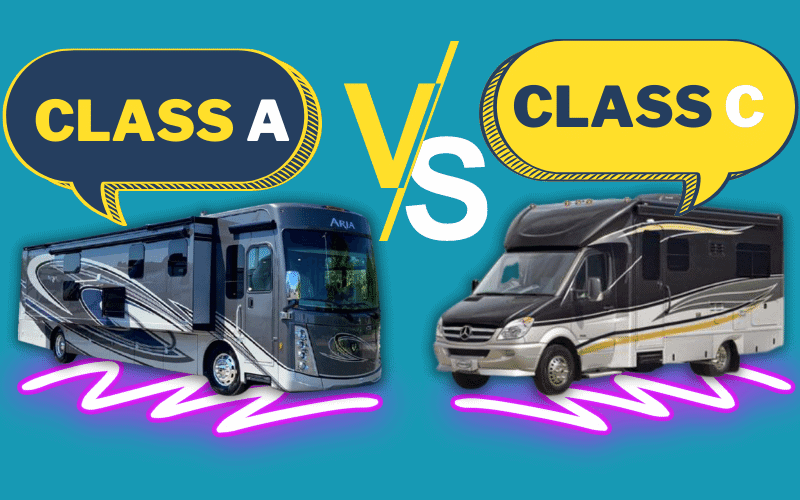
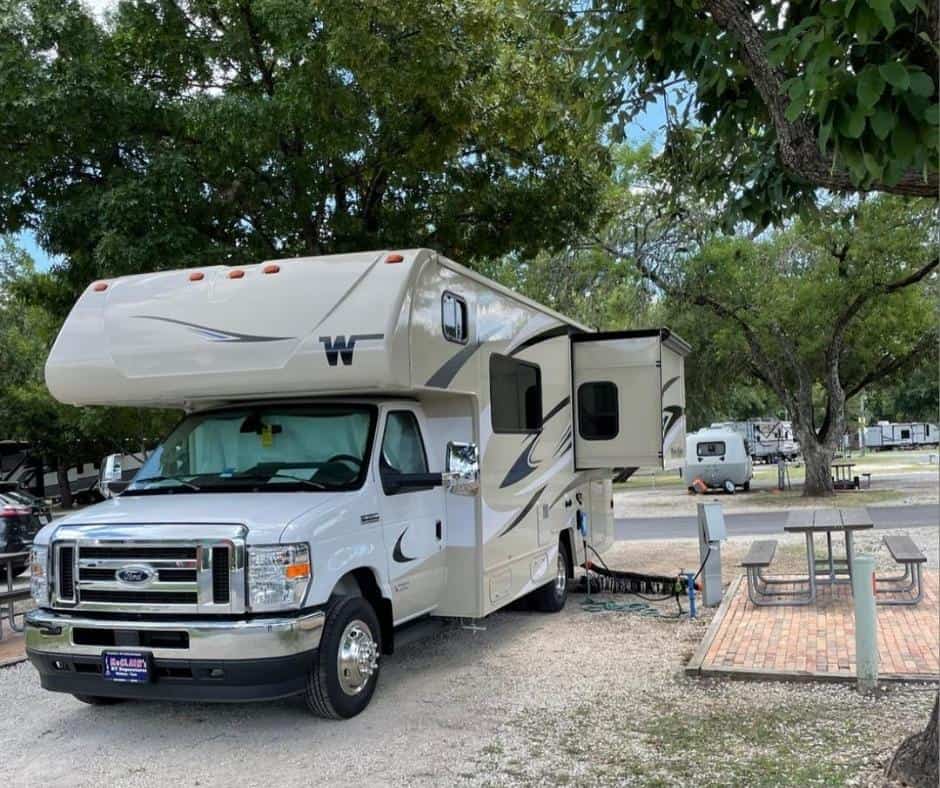
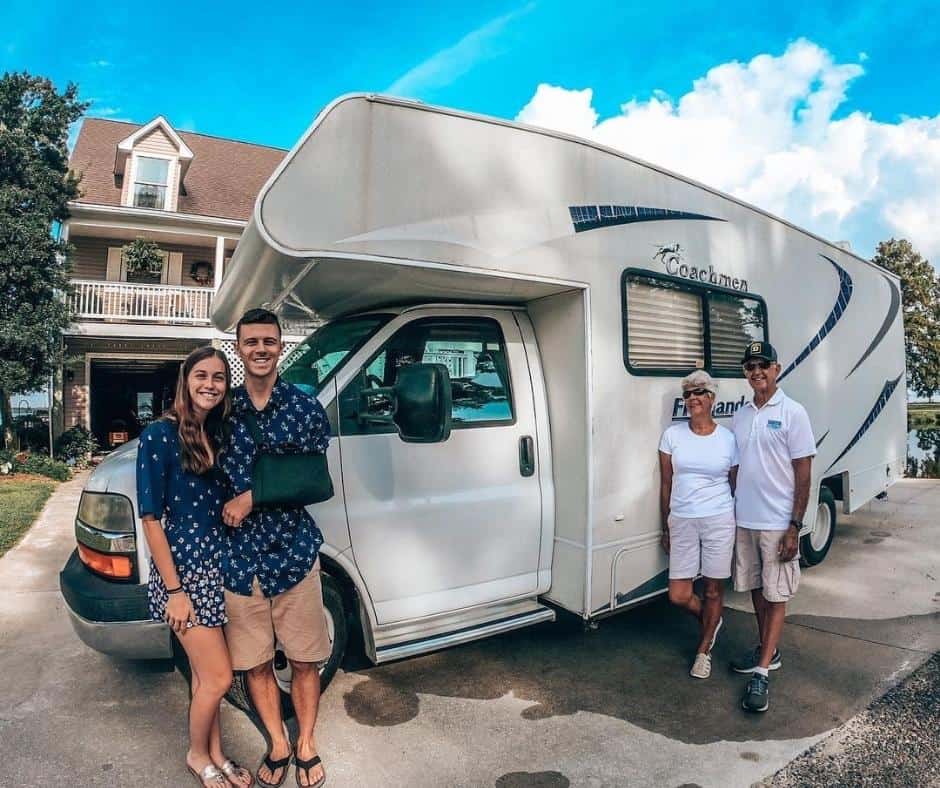
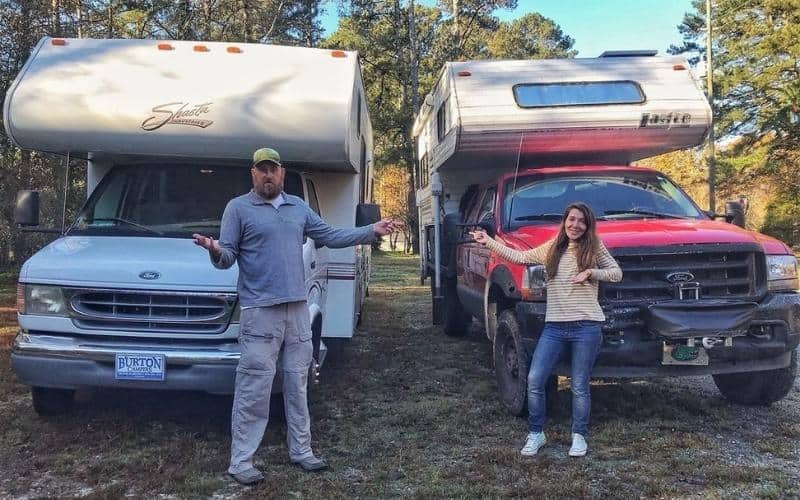
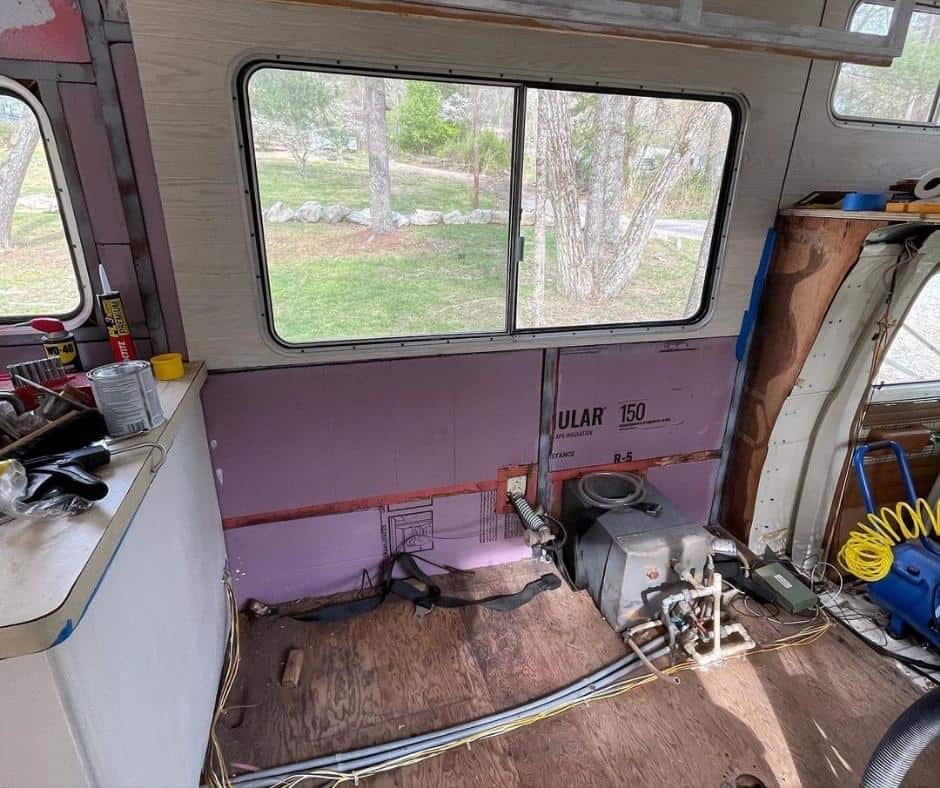
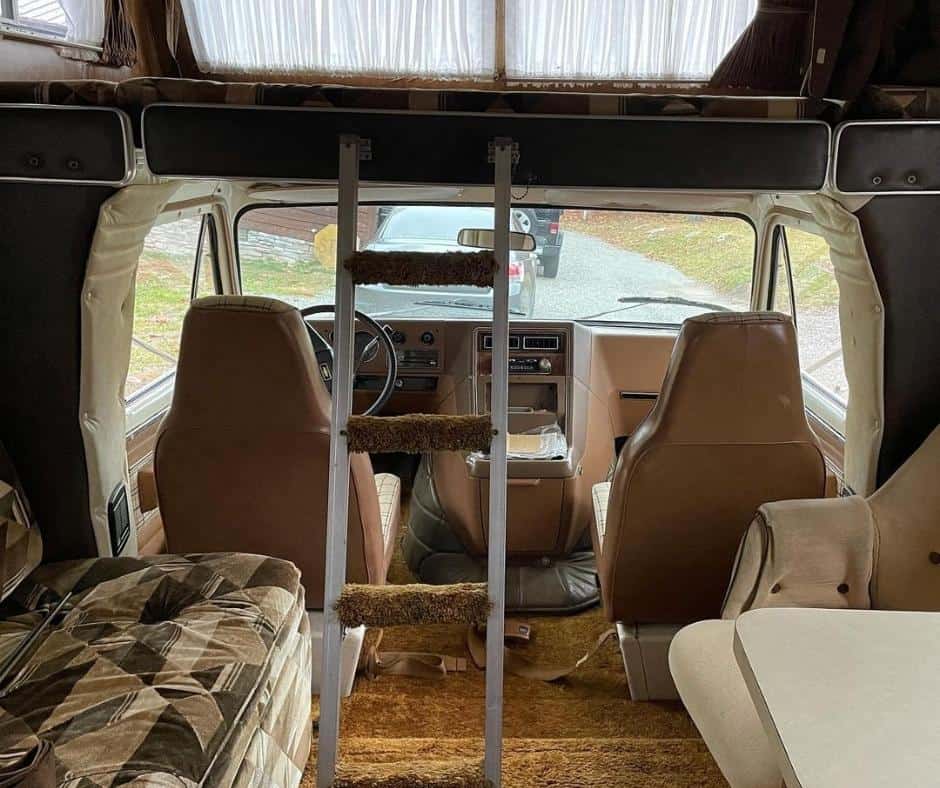
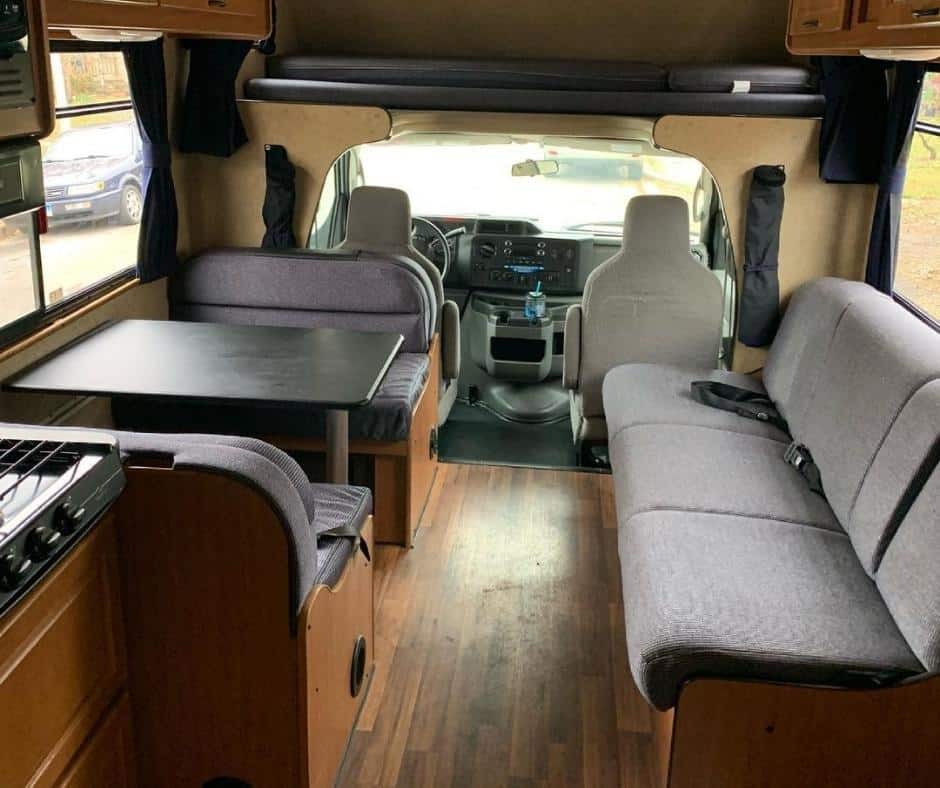

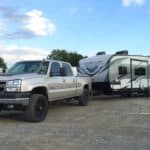

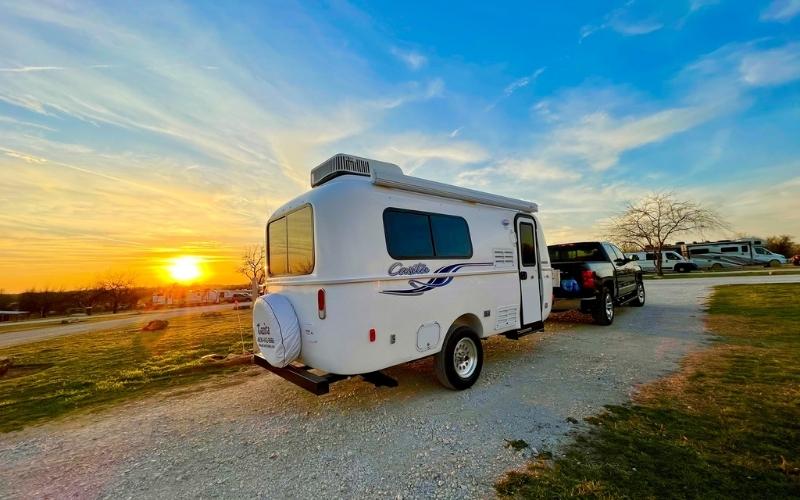
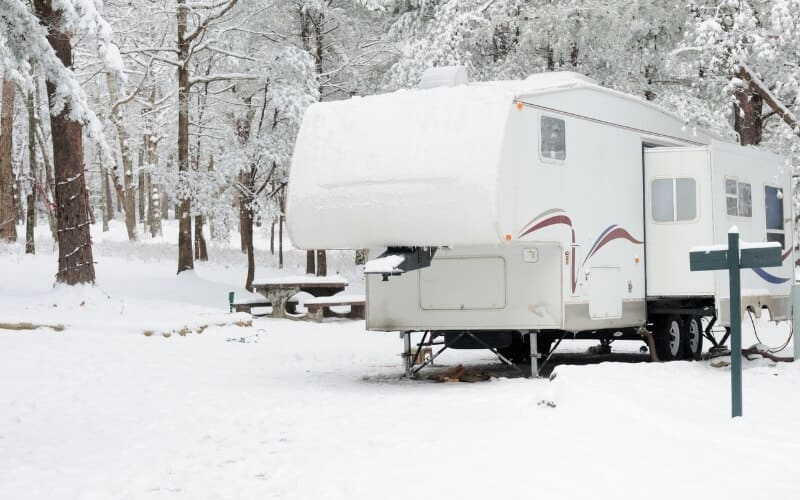
![10 Best 2 Bedroom RVs in [currentyear]: Top Rated Travel Trailer Floor Plans 18 Awesome Travel Trailers With 2 Bedrooms](https://www.rvingknowhow.com/wp-content/uploads/2019/12/Awesome-Travel-Trailers-With-2-Bedrooms.jpg)
1 Comment
Wayne Hanson
1 year agoGreat information for this Newbie considering full time for two @ our FurKids.